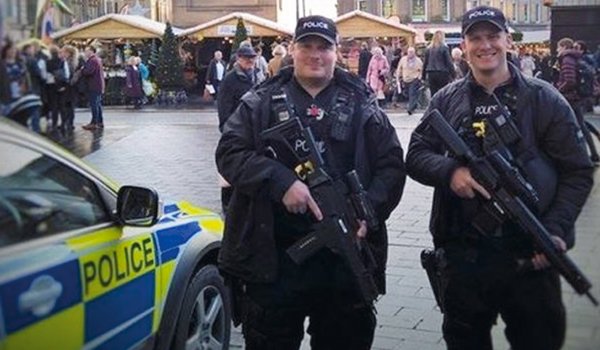Reassuring presence?
Following the outcry over the presence of armed officers in a Newcastle market, Police Professional looks at how forces can place their increasing number of firearms equipped personnel in public without causing alarm.
Last month, Northumbria Police was criticised after armed officers were pictured smiling at a Christmas market. While most of the coverage of this incident focused on the officers cheerful expressions, the underlying issue is far more serious why certain members of the public were so alarmed to see armed officers deployed in this context. Although the force insisted the officers were there purely to reassure the public and were not posted in response to any specific threat, the intended effect was clearly not entirely successful. Many people commented that armed police should not be used unless there is a specific need to do so, and others claimed that the sight of officers carrying assault weapons made them feel more afraid. Given the current climate, this attitude seems counter-intuitive. The UK terror threat level has been at severe since 2014, and armed police can provide invaluable defence against potential attacks. Even before last months attack on a Christmas market in Berlin, intelligence suggested that terrorists are changing tactics, with a recent Europol report noting a shift among extremist groups to prioritising soft targets such as shopping centres and tourist attractions rather than more traditional locations like airports or government buildings. Therefore a case can be made for utilising tactical reassurance. As concern about the terror threat grows, it is likely that more armed officers will be deployed to cover public events in the UK. Similarly, in a time of shrinking resources, forces should be encouraged to make the most efficient use of whatever assets they have. Why, though, does the public react so negatively to these deployments, and how can this reaction be managed? It seems to me that whats really important is context, said Gavin Hales, deputy director of the Police Foundation. There are contexts in which the public are used to the idea there may be armed police present, for instance an airport or a major rail terminal, or the Palace of Westminster. These places have traditionally been associated with a particular kind of threat, and the public understands that. Seeing an armed police officer when you go to the airport is not particularly unusual, so it tells you something you already know, which is that airports have historically been targeted. The issue with a market place in Newcastle is this is not the sort of place where the public is accustomed to seeing armed police officers. Mr Hales statement is supported by recent experience. Last year, Police Scotland was criticised after armed officers were pictured buying lunch in a Redding supermarket. In contrast, the same negative reaction does not often appear in the capital, where armed officers are a far more common sight. When British Transport Police announced in October that armed officers could soon be allowed to take the Tube between jobs instead of relying on overground transport, the public reaction was minimal, largely because they were used to seeing specialist resources in these locations. However, while frequent exposure will lessen negative public reaction, there will always be objection to the sight of weapons on the streets. Despite this, many forces seem content to attempt tactical reassurance without properly understanding its true benefits. There is almost no academic research on the extent to which the presence of armed officers reassures the public. However what information exists implies the picture is at best mixed. A survey by the Police Firearms Officers Association found that four in ten armed officers do not feel respected by the public, and 43 per cent were unsure about how the organisational response to incidents makes the public feel safer. Despite this, according to Mr Hales, at least parts of the police service have an unwavering belief that the tactic is successful. Northumbria Polices explanation of the deployment makes it clear that the armed officers were meant to reassure the public that in a time of heightened threat, there were armed police in


